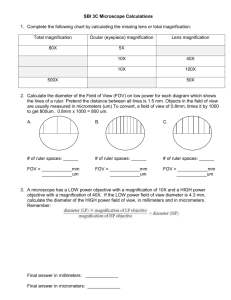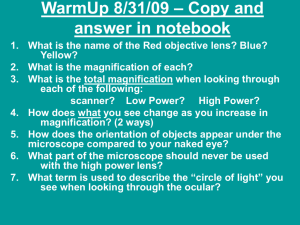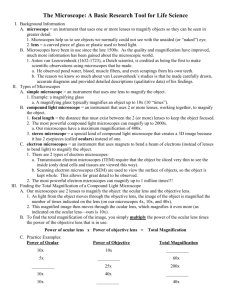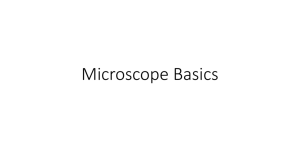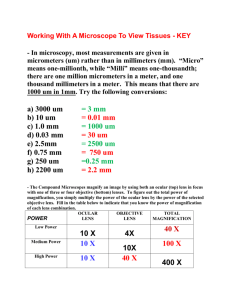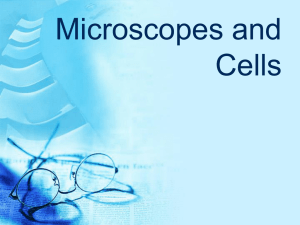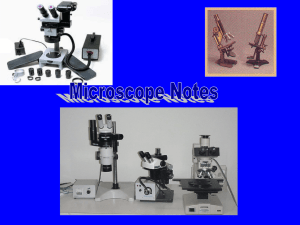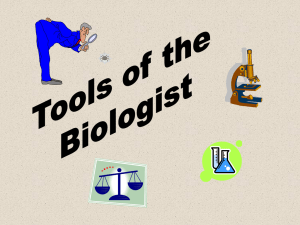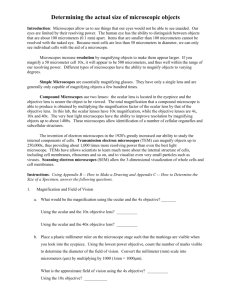Microscopes and Basic Measurement
advertisement
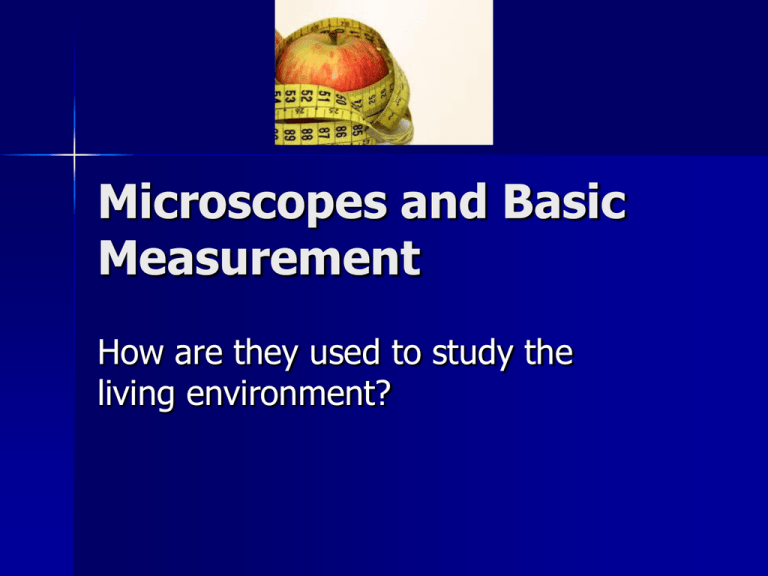
Microscopes and Basic Measurement How are they used to study the living environment? Measuring and Units Use a standardized system (metric system) – Meters = length – Gram = mass – Liter = volume Why Use Metric? Base 10 system Easier to convert units Simply multiply or divide by 10 to change unit Prefixes Used to show smaller or larger measurements – – – – – – – – – Mega Kilo Hecto Deka Deci Centi Milli Micro Nano Important Unit for Microscopes Micrometers (microns) = µm 1/1000th of a millimeter 1000 micrometers = 1 mm How Big is a Micron? Early Microscopes Anton Van Leeuwenhoek (1670’s) First to see and describe single celled organisms (protozoa) Robert Hooke (1665) Coined term “cell” Earliest Microscope? Parts of a Compound Microscope Contain two lenses that cause light rays to bend in such a way to produce an enlarged image. Lenses: Ocular Lens: eyepiece lens Objective Lens: can be low, medium or high power Look at magnification on lens Lower power is smaller in size Letting in Light: Mirror or Illuminator: directs light up through the specimen Diaphragm: regulates amount of light – Disk with different sized “iris” or openings Arm: connects stage and body tube Stage: platform with opening over which a specimen is placed (clips to hold slide) Base: supports microscope Eyepiece (ocular): part you look through, holds ocular lens, magnifies 10x Body tube: connects eyepiece & objective lenses Nosepiece: holds objective lenses (can be turned) Objective Lens: magnifies image, can be low, medium, high power Focusing: Coarse Adjustment Knob: use on low power only!! (never use with high power you can break your slide!) Fine Adjustment Knob: once low power is focused switch to high power and use fine adjustment. Magnification How much can you enlarge the image? Ex: 100x = 100 times as big Finding Total Magnification Multiply strengths of two lenses you are using. – Ocular lens x Objective lens Ex: Ocular = 10x High Power Objective= 45x Total Magnification = (10 x 45) = 450x Practice Find Total Magnification: 1. Ocular 2x, Objective 30x = 2. Ocular 10x, Objective 60x = 3. If Ocular is 10x and Total mag. = 350x What is the strength of the objective lens? Note: As you increase magnification you need to let in more light to see your specimen (adjust diaphragm) Resolution How sharp can you get the image? Ability of microscope to distinguish two objects as being separate (ex: one cell from another) What Happens to Image? Compound Microscopes: – Image becomes inverted and upside down What Happens to Image? When you increase magnification – Object appears larger – Field of view gets smaller Finding Field of View (F.O.V) Under Low Power: Use millimeter ruler Ex: 1.5mm Convert to micrometers 1 mm = 1000 micrometers So 1.5 mm = 1,500 micrometers (Move decimal over 3 to right) Finding Field of View (F.O.V) Under Medium or High Power Need to set up a proportion Remember!! – As magnification increases FOV decreases Low power Magnification = High power FOV High power Magnification Low power FOV Ex: 100x 500x = HP FOV 1500 micrometers 500x = 150000 HP FOV = 300 micrometers Determining the Size of an Object Under a Microscope View and draw object on low power Estimate how many objects would fit across diameter of field of view Divide the diameter of FOV by the number of objects that can fit across it. Ex: – Three letter “e”s fit across FOV of 1800 micrometers – Each letter is about 600 micrometers 1800 micrometers = 600 µm 3 letter “e” Comparing Microscopes Compound Light Microscope Magnification 40x – 1500x – 2-D image, inverted, upside down – Uses stains to see details (may kill specimen) – Specimen must be thin to allow light through Dissecting Microscope: Low mag. 10x – 20x See true image (right side up) Specimen can be alive Can use tools for dissecting specimen Binocular (two ocular lens) so you can see 3-D image Phase Contrast Microscope: Uses special filters to show depth without staining. Can see interior details of living cells Electron Microscopes: Much higher magnification and resolution than microscopes that use light. Magnifies up to 200,000x Uses beam of electrons Sample placed in vacuum Cannot view living specimens Allowed scientists to see structure of cellular organelles Other Equipment Centrifuge: – Separates cell components by density – Whirls test tubes at high speed – Heaviest at bottom Micro-dissecting Tools Used to dissect cells
